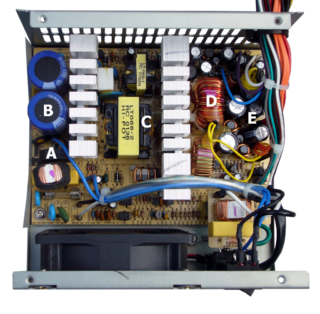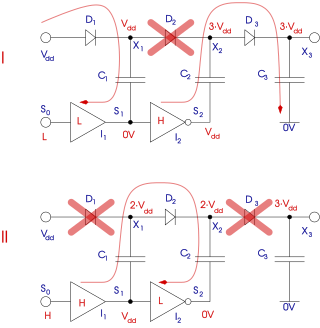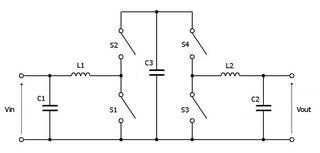Related Research Articles

A high-voltage direct current (HVDC) electric power transmission system uses direct current (DC) for electric power transmission, in contrast with the more common alternating current (AC) transmission systems.

A power inverter, inverter, or invertor is a power electronic device or circuitry that changes direct current (DC) to alternating current (AC). The resulting AC frequency obtained depends on the particular device employed. Inverters do the opposite of rectifiers which were originally large electromechanical devices converting AC to DC.

A switched-mode power supply (SMPS), also called switching-mode power supply, switch-mode power supply, switched power supply, or simply switcher, is an electronic power supply that incorporates a switching regulator to convert electrical power efficiently.

A Flexible Alternating Current Transmission System (FACTS) is a family of Power-Electronic based devices designed for use on an Alternating Current (AC) Transmission System to improve and control Power Flow and support Voltage. FACTs devices are alternatives to traditional electric grid solutions and improvements, where building additional Transmission Lines or Substation is not economically or logistically viable.
A DC-to-DC converter is an electronic circuit or electromechanical device that converts a source of direct current (DC) from one voltage level to another. It is a type of electric power converter. Power levels range from very low to very high.

Power electronics is the application of electronics to the control and conversion of electric power.

A variable-frequency drive is a type of AC motor drive that controls speed and torque by varying the frequency of the input electricity. Depending on its topology, it controls the associated voltage or current variation.

A charge pump is a kind of DC-to-DC converter that uses capacitors for energetic charge storage to raise or lower voltage. Charge-pump circuits are capable of high efficiencies, sometimes as high as 90–95%, while being electrically simple circuits.
A microgrid is a local electrical grid with defined electrical boundaries, acting as a single and controllable entity. It is able to operate in grid-connected and in island mode. A 'stand-alone microgrid' or 'isolated microgrid' only operates off-the-grid and cannot be connected to a wider electric power system. Very small microgrids are called nanogrids.

A boost converter or step-up converter is a DC-to-DC converter that increases voltage, while decreasing current, from its input (supply) to its output (load).

A static synchronous compensator (STATCOM) is a shunt-connected, reactive compensation device used on transmission networks. It uses power electronics to form a voltage-source converter that can act as either a source or sink of reactive AC power to an electricity network. It is a member of the FACTS family of devices.
A line filter is an electronic filter that is placed between the mains electricity input and internal circuitry of electronic equipment to attenuate conducted radio frequencies radio frequency interference (RFI), also known as electromagnetic interference (EMI). Often it is either integrated into the power entry module or as a separate module.

In electronics, a split-pi topology is a pattern of component interconnections used in a kind of power converter that can theoretically produce an arbitrary output voltage, either higher or lower than the input voltage. In practice the upper voltage output is limited to the voltage rating of components used. It is essentially a boost (step-up) converter followed by a buck (step-down) converter. The topology and use of MOSFETs make it inherently bi-directional which lends itself to applications requiring regenerative braking.
A solid-state AC-to-AC converter converts an AC waveform to another AC waveform, where the output voltage and frequency can be set arbitrarily.
An HVDC converter converts electric power from high voltage alternating current (AC) to high-voltage direct current (HVDC), or vice versa. HVDC is used as an alternative to AC for transmitting electrical energy over long distances or between AC power systems of different frequencies. HVDC converters capable of converting up to two gigawatts (GW) and with voltage ratings of up to 900 kilovolts (kV) have been built, and even higher ratings are technically feasible. A complete converter station may contain several such converters in series and/or parallel to achieve total system DC voltage ratings of up to 1,100 kV.
A Z-source inverter is a type of power inverter, a circuit that converts direct current to alternating current. The circuit functions as a buck-boost inverter without making use of DC-DC converter bridge due to its topology.
Switching Control Techniques address electromagnetic interference (EMI) mitigation on power electronics (PE). The design of power electronics involves overcoming three key challenges:
- power losses
- EMI
- harmonics

Random pulse-width modulation (RPWM) is a modulation technique introduced for mitigating electromagnetic interference (EMI) of power converters by spreading the energy of the noise signal over a wider bandwidth, so that there are no significant peaks of the noise. This is achieved by randomly varying the main parameters of the pulse-width modulation signal.

Low-frequency electromagnetic compatibility is a specific field in the domain of electromagnetic compatibility (EMC) and power quality (PQ), which deals with electromagnetic interference phenomena in the frequency range between 2 kHz and 150 kHz. It is a special frequency range because it does not fit in the PQ problems, with range of up to 2 kHz, where relative levels of voltage and current can have massive impact on efficiency and integrity of electric systems, and neither in the conducted EMC range, which starts at 150 kHz and influences mainly informational systems, and already too far from radiated EMC range, which starts at 30 MHz and goes up to 1 GHz.
References
- ↑ Arrillaga, Jos (1998). "Chapter 1". High Voltage Direct Current Transmission (Second ed.). Institution of Electrical Engineers. p. 1–9. ISBN 0852969414.
- ↑ Tricoli, Pietro (Mar 2017). "Efficiency assessment of modular multilevel converters for battery electric vehicles" (PDF). IEEE Transactions on Power Electronics . 32 (3): 2041–2051. Bibcode:2017ITPE...32.2041Q. doi:10.1109/TPEL.2016.2557579. S2CID 8412590.
- ↑ Tolbert, Leon M. (Jan–Feb 1999). "Multilevel Converters for Large Electric Drives". IEEE Transactions on Industry Applications. 35 (1): 36–44. CiteSeerX 10.1.1.468.9074 . doi:10.1109/28.740843.
- ↑ Habib, Salman (Jan 2018). "Assessment of electric vehicles concerning impacts, charging infrastructure with unidirectional and bidirectional chargers, and power flow comparisons". Int J Energy Res. 42 (11): 3416–3441. doi: 10.1002/er.4033 . S2CID 104109087.
- ↑ Unruh, Roland; Schafmeister, Frank; Böcker, Joachim (November 30, 2020). "11kW, 70kHz LLC Converter Design with Adaptive Input Voltage for 98% Efficiency in an MMC". 2020 IEEE 21st Workshop on Control and Modeling for Power Electronics (COMPEL). pp. 1–8. doi:10.1109/COMPEL49091.2020.9265771. ISBN 978-1-7281-7160-9. S2CID 227278364 – via IEEE Xplore.
- ↑ Unruh, Roland (October 2020). "Evaluation of MMCs for High-Power Low-Voltage DC-Applications in Combination with the Module LLC-Design". 22nd European Conference on Power Electronics and Applications (EPE'20 ECCE Europe). doi:10.23919/EPE20ECCEEurope43536.2020.9215687. ISBN 978-9-0758-1536-8. S2CID 222223518.